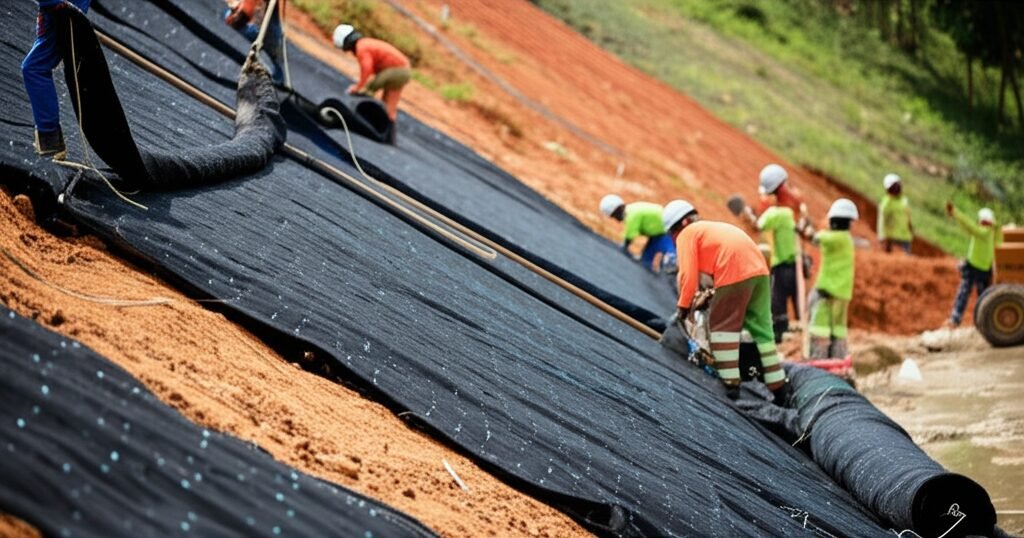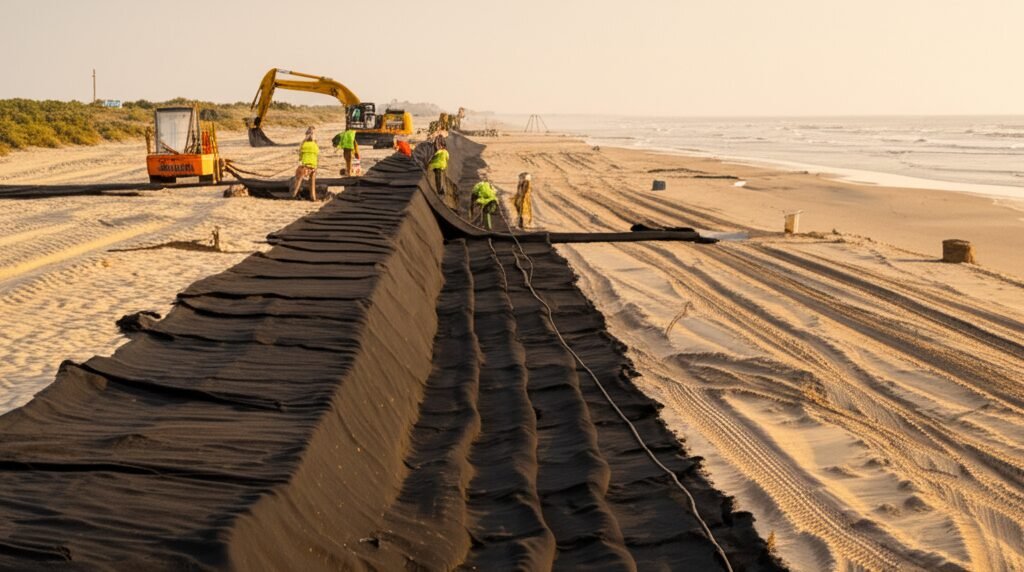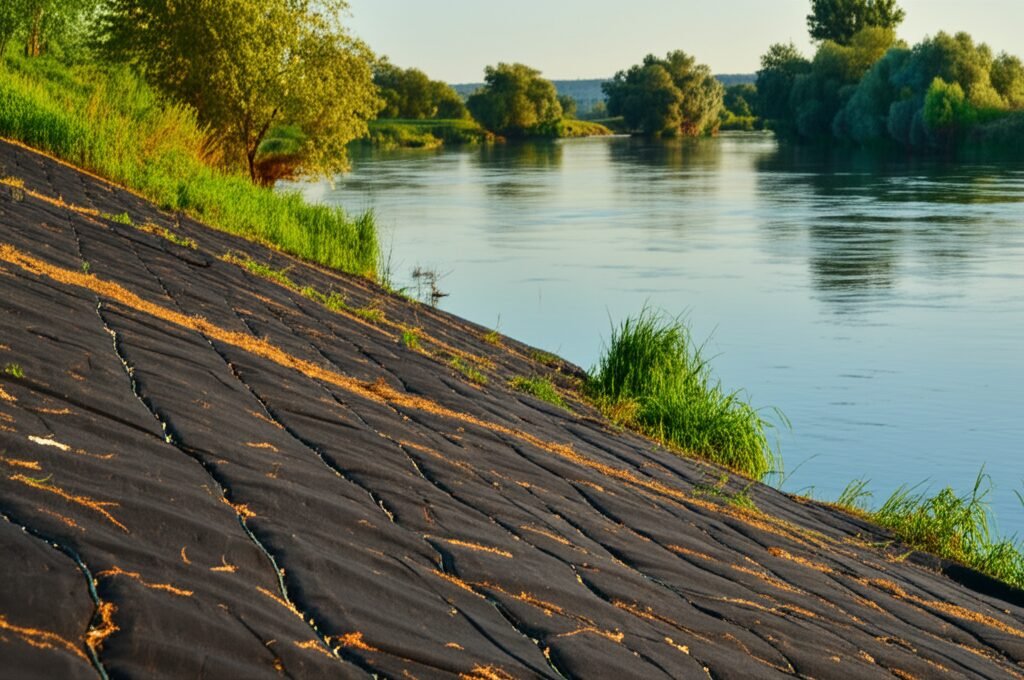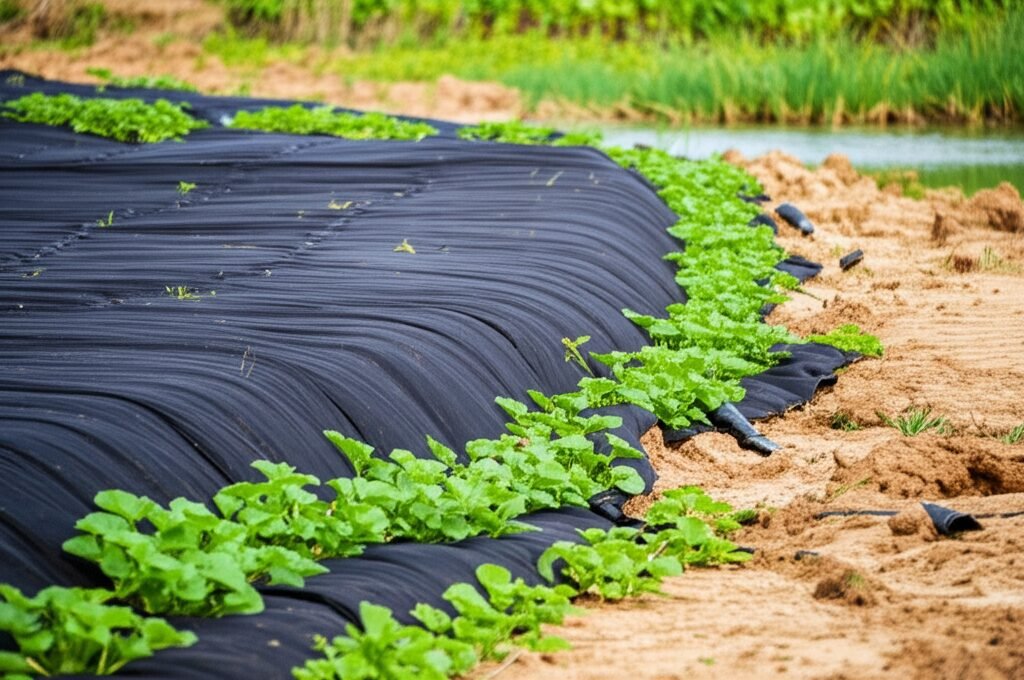Effective Coastal Erosion Solutions and Riverbank Stabilization with Geotextile Mattresses
Key Takeaways:
- Geotextile mattresses are fabric containers filled with sand, concrete, or grout, used to stop erosion.
- They work really well for protecting coastlines from waves and riverbanks from currents.
- Benefits include stability, letting water pass through (filtration), and sometimes helping plants grow back.
- They can be more environmentally friendly and cheaper than traditional hard structures like concrete walls.
- Proper installation and choosing the right type for the site are super important.
- They help protect land, property, and important natural habitats from being washed away.
What Are Geotextile Mattresses Actually?
So, what exactly is a geotextile mattress? Think of ’em like big, tough fabric bags or envelopes. They’re made from specially engineered woven or non-woven fabrics – synthetic stuff like polypropylene or polyester, usually. These fabrics are strong, they last a long time, and they let water pass through ’em, which’s important. The idea is you lay these fabric containers down on the area you wanna protect – like a riverbank or a beach thats eroding – and then you fill ’em up. What you fill them with depends on the job, but its commonly sand, gravel, or a special type of concrete called grout. Once filled, they form a heavy, stable but still kinda flexible layer. This layer acts like armour against the forces causing erosion, like waves crashing or river water flowing fast. It holds the soil or sand underneath in place, stopping it from getting washed away. The ‘mattress’ part of the name comes from their shape, kinda like a big, flat mattress laid over the ground.
The fabric itself is key. It needs to be porous enough to let water pressure escape from behind or below the mattress. If water gets trapped, it can build up pressure and push the mattress out of place or cause other problems. This is where things like Advanced Filtration Geotextile Mattress Systems come in. They are designed specifically with fabrics that have just the right pore size – small enough to keep the soil particles in, but big enough to let water out easily. This filtration ability is one of the big pluses over solid concrete walls, which can cause scouring problems at their base because water can’t get through. It’s a clever bit of engineering, using fabric technology to solve an age-old problem. You’ll often see them with specific patterns sewn into them too, which helps control where the fill goes and gives the final structure more stability. Some designs even have special loops or connection points to link multiple mattresses together, creating a really large, cohesive protective layer for bigger areas. It ain’t just a bag of sand; there’s some real thought gone into how these things work best. They need to handle UV light, potential damage, and the specific chemicals in the water or soil too.
Why Erosion Control Matters So Much on Coasts and Rivers
Erosion along coasts and riverbanks ain’t just a little bit of dirt washing away. It’s a massive headache with serious consequences. On the coast, you’ve got relentless wave action, storm surges, and changing sea levels constantly eating away at the shoreline. This means beaches disappear, cliffs crumble, and eventually, homes, roads, and businesses built near the coast are threatened. Think about the value of waterfront property – erosion literally washes that value away. It destabilises the land, making it unsafe. We’ve all seen pictures after big storms where houses are teetering on the edge of a new cliff, that’s coastal erosion in action. It also damages crucial coastal habitats like dunes and marshes, which are important nursery grounds for fish and protect inland areas from flooding. Lose those, and the whole ecosystem gets messed up.
Rivers bring their own set of problems. Fast-flowing water, especially during floods, has incredible power to scour away riverbanks. This widens the river channel in ways we dont want, eating into valuable farmland or threatening infrastructure like bridges, pipelines, and buildings located near the river. Sediment washed from the banks clouds the water, harming fish and aquatic life, and can silt up reservoirs or navigation channels downstream, which then costs a fortune to dredge. Uncontrolled riverbank erosion can change the course of a river over time, leading to property boundary disputes and unpredictable flooding patterns. Protecting these banks is vital for maintaining stable river systems, protecting human investments, and preserving water quality. It’s why using Specialized Geotextile Protection for Critical Infrastructure is becoming so common. You can’t just let the river chew away at the foundations of a bridge, right? You need something strong and reliable there. Seeing a riverbank just collapse during a flood is pretty scary stuff; it shows you the raw power of water and why managing it properly is essential.
How Geotextile Mattresses Stop Coastal Erosion
Geotextile mattresses are pretty slick tools for fighting coastal erosion. Their main job is to act like a shield or armour for the shoreline. When waves hit the coast, they carry a lot of energy. If they hit bare sand or soil, they churn it up and carry it away. But when waves hit a geotextile mattress filled with sand or concrete, the mattress absorbs and dissipates a lot of that energy. The weight and structure of the mattress mean it doesnt get easily moved, and the fabric casing stops the fill material (and the crucial soil underneath) from washing out. Think of it like putting a protective blanket over the vulnerable edge of the land. It effectively reduces the direct impact of the waves on the erodible material below. This is especially important during storms when wave energy is way higher.
Another key way they work is by preventing something called ‘undercutting’ or ‘scour’. This happens when waves hitting a hard structure (like a seawall) are deflected downwards, digging out the material at the base of the structure. This can eventually make the structure unstable and cause it to fail. Geotextile mattresses, being somewhat flexible and permeable, are less prone to causing this kind of scour. Water can pass through the fabric, reducing the reflected wave energy and pressure build-up. Proven Geotextile Mattress Projects for Water Infrastructure often show how effective they are in preventing this specific type of failure mechanism, which plagues older, rigid coastal defences. They can conform better to the existing seabed or beach profile, creating a more stable transition. Some designs, like the Triton Marine Mattress System, are specifically engineered for these tough marine environments, designed to withstand wave forces and saltwater conditions over the long term. They basically hold the line, stopping the sea from advancing inland.
Tackling Riverbank Erosion with Geotextiles
Rivers might not have the big crashing waves of the coast, but fast currents, especially round bends or during high water levels, can be just as destructive to banks. Geotextile mattresses work great here too, but in slightly different ways. The main principle is still armoring the bank. By laying these filled mattresses along the toe (the bottom edge) and slope of the riverbank, you create a barrier that the current cant easily erode. The weight stops the soil being washed away particle by particle. It stabilizes the bank profile, preventing slumping and collapse which is super common when banks get saturated and then the water level drops quickly.
A really neat thing about using them on riverbanks is how they can work with nature. Some systems, like Advanced Vegetation Geotextile Mattress Systems, are designed specifically to allow plants to grow through them. The mattress provides the initial stability, stopping the bank washing away imediatly, but then native grasses, shrubs, or trees can establish their roots through the fabric and into the soil beneath. These roots then provide long-term, natural reinforcement for the bank, binding the soil together. Over time, the vegetation can completely cover the mattress, creating a ‘green’ solution that looks natural and provides excellent habitat. This is a big plus compared to just dumping rock (riprap) or building concrete walls, which offer no ecological value. As highlighted in resources like “Engineered Geosynthetics Offer Riverbank Erosion Protection“, this combination of engineered stability and natural revegetation is a really effective approach. It provides immediate protection from the mattress, and then the plants take over for the long haul, kinda like giving nature a helping hand to heal itself. We used a system like this on a tricky bend on a local river project, and within two seasons, you could barely see the mattress for the willow growth – bank’s solid as a rock now though.
The Big Advantages of Using These Mattresses
So why choose geotextile mattresses over, say, just piling up a load of rocks or pouring concrete? Well, there are quite a few good reasons. One big one is their flexibility. Unlike rigid concrete structures, mattresses can conform better to uneven riverbeds or seabeds. If there’s a bit of settlement underneath them, they can often adjust without cracking or failing completely. This makes them more resilient in dynamic environments where the ground might shift a bit. They’re also generally easier and faster to install than traditional methods. You don’t necessarily need massive, specialised heavy equipment for placement, especially for smaller projects. Filling them in place with locally sourced sand or grout can also cut down on transportation costs and hassle compared to hauling in huge quantities of rock armour.
Cost is often a major factor, and systems like Raised-Pattern Geotextile Mattress Systems Cut Costs 40% highlight the potential savings. While the initial material cost might be there, savings on transport, installation time, and potentially less need for deep foundation work can make them very competitive economically. Then there’s the environmental angle. As mentioned before, they allow water to pass through, preventing pressure build-up and reducing scour. Systems designed for vegetation allow banks and shorelines to become green again, providing habitat rather than destroying it. This often makes getting environmental permits easier compared to hard armoring. Compared to just dumping rock riprap, a properly designed mattress provides a more uniform and controlled level of protection. Products like ACEFormer™ also focus heavily on effective erosion and sediment control during and after installation. The Advantages and Applications of Geotextile Mattresses in Erosion Control page goes into more detail on these points, showing they offer a good balance of engineering performance, cost-effectiveness, and environmental consideration. For many coastal and river situations, they just make alot of sense.
Installation and Considerations
Putting geotextile mattresses in place isn’t just chucking bags on the ground, mind. There’s a proper way to do it to make sure they work correctly and last ages. First up is site preparation. You need to clear the area where the mattress will sit, removing any big rocks, debris, or unstable vegetation that could tear the fabric or prevent it lying flat. The slope might need to be graded to the correct angle specified in the design. Sometimes, a foundation layer, maybe of gravel or another geotextile, is needed underneath, especially on really soft ground. Getting the prep right is fundemental for the whole system’s stability.
Next comes placement. The empty mattresses are carefully unrolled or laid out across the prepared area. They often have connection points or overlaps designed to link them together securely, forming one continuous protective layer. You gotta make sure they’re positioned correctly according to the plan before you start filling. Filling is the critical stage. This is usually done using a pump if you’re using sand slurry or grout, or carefully placed aggregate if its a rock-filled type. The fill needs to be introduced in a controlled way to ensure the mattress fills evenly without causing stress points or voids. Special filling ports are sewn into the mattress fabric for this. You monitor the filling process to get the right thickness and tension in the fabric. The Geotextile Mattress Uses, Construction, Benefits & Installation Guide provides a good overview of these steps. Key considerations throughout include choosing the right type of mattress and fill for the specific forces it’ll face (waves, currents), ensuring the fabric has the right strength and filtration properties, and thinking about long-term durability, including UV resistance if its exposed. Expertise matters here; getting advice from specialists or manufacturers, like those associated with Li Gang: Expert Geotextile Mattress Manufacturing Leader, can make a big difference in project success. You dont want it failing after the first flood.
Real-World Examples and Success
You see these geotextile mattress systems used all over the place once you start looking, often protecting really important stuff. Think about bridge abutments and piers in rivers. The currents swirling around these structures can cause serious scour, undermining the foundations. Geotextile mattresses are often placed around the base of the piers like a protective collar, stopping the riverbed from washing away. It’s a much more targeted and often less visually intrusive solution than just dumping tons of rock. Similarly, underwater pipelines or cables crossing rivers or sea channels need protection from currents or anchors dragging. Laying mattresses over the top can provide that crucial shield. Proven Geotextile Mattress Projects for Water Infrastructure showcase these kinds of applications.
On coastlines, besides just protecting eroding beaches or cliffs directly in front of property, they’re used to build groynes or submerged breakwaters. These structures, made from filled mattresses, stick out from the coast or sit just offshore. They work by altering wave patterns and trapping sand, helping to build up beaches naturally rather than just armoring the existing line. It’s a softer engineering approach. In ports and harbours, they protect quay walls from propeller wash from ships and prevent erosion along dredged channels. Sometimes, monitoring the effectiveness of these installations involves techniques mentioned in reports like the Research on Geospatial Technologies in the Americas, using things like sonar or satellite imagery to track changes in the seabed or shoreline over time after the mattresses are installed. The success stories often highlight not just the erosion control itself, but also the quicker installation times and reduced environmental impact compared to what might have been done 30 years ago. Its clever tech being used smartly.
Choosing the Right System
Picking the right geotextile mattress system isn’t a one-size-fits-all deal. You’ve really got to match the product to the specific conditions you’re facing on site. What works brilliantly on a slow-moving river might be totally inadequate for a high-energy coastline battered by storms. Key things to consider include the hydraulic conditions – how strong are the currents or waves? This determines how heavy and robust the mattress needs to be, and what type of fill (sand, grout, rock) is most suitable. Grout-filled mattresses tend to be heavier and more rigid once cured, good for higher energy spots. Sand-filled ones are more flexible.
Then there’s the soil type on the bed or bank. Is it fine sand, silt, clay, or gravel? This affects the required filtration properties of the geotextile fabric. You need a fabric with pore openings small enough to hold back the existing soil particles, otherwise, the soil will slowly wash out through the mattress fabric over time, causing settlement. But the pores still need to be large enough to let water pressure escape easily. This is where specialized designs like filter point mattresses come in, offering controlled filtration points. Getting this balance right is absolutely critical for long-term performance, as discussed in technical papers like the Analysis of Geosynthetic Materials in Civil Engineering.
You also need to think about environmental goals. Do you want vegetation to establish? If so, you need a vegetation-friendly mattress system designed to allow root penetration. Is marine habitat a consideration? Some mattress types might be more conducive to colonization by marine life than others. Durability factors like UV exposure (if it won’t be permanently submerged or covered) and potential for abrasion or vandalism also play a role in selecting the right fabric type and thickness. Because there are so many variables, its often best to get advice from ppl who know their stuff. Consulting with Expert Geotextile Mattress Solutions for Erosion Control can help ensure you select the most appropriate and cost-effective system for your specific coastal or riverbank challenge. They can help analyse the site conditions and recommend the best approach.
Ultimately, geotextile mattresses offer a really versatile and effective way to combat erosion in those tough coastal and riverbank areas. They provide stability, manage water flow smartly, and can even help nature reclaim the banks. Compared to some of the old-school methods, they often stack up well on cost, installation speed, and environmental impact. If you’ve got land washing away by the water, exploring how you can Transform Terrains with Durable Geotextile Mattresses is definitely worth your time.
Frequently Asked Questions (FAQs)
Q1: How long do geotextile mattresses last?
A: Properly designed and installed geotextile mattresses can last a very long time, often decades. The lifespan depends on the quality of the fabric (especially its UV resistance if exposed), the type of fill used, the severity of the environmental conditions (wave energy, currents), and whether they get damaged mechanically. Manufacturers often provide estimated design lives based on materials testing.
Q2: Are they bad for the environment?
A: Generally, they’re considered more environmentally friendly than traditional ‘hard’ structures like concrete seawalls. They allow water passage, reducing scour. Systems designed for vegetation actively promote habitat regrowth. The main materials (polyester, polypropylene) are relatively inert, but like any construction, installation needs care to minimise disturbance.
Q3: Can plants really grow through them?
A: Yes, specific types called vegetation mattresses are designed for this. They use fabrics that allow plant roots to penetrate through into the soil below while still providing erosion protection. This creates a ‘green’, living armor over time.
Q4: Are they expensive compared to rocks (riprap)?
A: It varies. The mattress material itself costs money, but installation can be faster and require less heavy equipment than placing large amounts of rock. Transport costs can also be lower if suitable fill material (like sand) is available locally, whereas large rock often needs hauling from far away. Sometimes, systems claim significant cost savings. You need to compare the total project cost, including materials, transport, and installation for a specific site.
Q5: Can I install them myself?
A: For very small applications, maybe, but generally, professional installation is recommended. Proper site preparation, correct placement and connection of units, and controlled filling are crucial for them to work properly and achieve their design life. Getting it wrong can lead to failure. Contacting experts is usually the best starting point.












